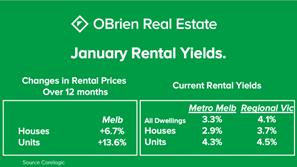January report.


Our purpose.
To create a place where we can facilitate our people’s growth.




To create a place where we can facilitate our people’s growth.


Family.
Our colleagues are our broader family, assist when needed and when in need.
Mutuality. Respect our colleagues and our clients as you would like to be respected.

Realising potential. Unlock your full potential, encourage and support your colleagues.
Embrace change. Strive for excellence; be open minded and willing to embrace change.
Health and energy. Work towards being well balanced within yourself.




With this being our first where real estate information is on the house.
With this being our first edition for 2023 I thought we combine results for both December and January with an updated market information share.
This time last year the median value for a house in Melbourne for the first time ever hit $1 million according to Corelogic’s home index, and today if you’re looking to buy a house rather than a unit, you can expect the median value of that house to be $100,000 less than this time last year. If we look at Sydney, the median value for houses and units has now dropped to be under $1 million, that’s quite a change. However, the declines in we have been experiencing over the last 12 months are definitely easing. January has not been a quiet month, with overseas student numbers surging we are experiencing huge rental demands and particularly from Chinese students which is due authorities no longer recognising online studies as part of an academic degree or diploma. We expect the coming months to continue to be very strong and some of this rental demand to transfer into buying. The ASX 200 was also strong in January, it has its best January since 1994, increasing 6.2% for the month which is stark contract to January last year when it had it’s worst start to the year in 14 years.

No doubt, people, will be closely listening to the Reverse Bank’s announcement next Tuesday but it’s the comments from the Reserve Bank governor that will be even more important, because the market has already factored in the rate rise this February, so it is the future indications from the Reserve Bank governor that people should be listening into.

Melbourne Metro declines in the Home Value Index) over January fell 1.1%, and on a 12 month rolling average Melbourne prices are now 9.3% down for all dwelling types. Regional Victoria has also had a decline similar to last month easing 0.7%. Regional Victoria is now 3.5% down over the last 12 months, however let’s not forget that Regional prices in the previous rolling 12 month period grew an impressive 23.9%.

Looking at the rental market, rents in Metro Melbourne for units is in strong demand, people are now wanting to be close to universities and transport links again and in the Inner Melbourne market we have experienced a 30% increase in rents over the last 12 months and there are no signs of that slowing. Gross yields of units for investors is increasing strongly as you would expect with units now at 4.3% in Metro Melbourne and 4.5% in Regional Victoria, whereas this time last year we were sitting at 3.5% as a gross yield for Metro Melbourne.
That’s all for this month and remember the information provided is of a general nature you should always seek independent legal, financial, taxation or other advice in relation to your unique circumstances.












At the start of 2022, many had hoped it was going to be a more typical year post-COVID… however it was anything but typical!
There is no doubt that the impact of eight consecutive interest rate increases since May has resulted in the spring selling period being non-existent and the residential market in decline. Most markets however are still above pre-pandemic levels.
While it would appear the RBA is finally starting to slow the rate of increases as it chases down its inflation target, there remains a question of how high rates need to go before it is deemed under control.
Both Westpac and ANZ came out earlier last month forecasting that the cash rate could increase to at least 3.85 per cent between March and May before plateauing out. While CBA and NAB are remaining more optimistic predicting a peak of 3.1 and 3.6 per cent respectively.”
No matter who ends up being right, the result is a significant increase in monthly repayments for the average home loan borrower of between $800 and $1000 a month based on a $500,000 loan and depending on which forecast you run with.

The big question we are being asked is what will this do to home values?
While all major markets are now in decline, the rate of fall seems to be slowing according to the main research outlets.
For now, auction clearance rates appear to be remaining relatively strong at just over 60 per cent across the major capital markets and auction volumes are increasing, albeit at least 40 per cent lower than the same time last year.
With sales volumes remaining relatively low and clearance rates in check, it seems that the balance between supply and demand is stable for now, in turn slowing the fall in values.
According to the RBA however, around 23 per cent of all home loans were fixed over the past couple of years and are due to convert to variable by the end of 2023. The peak of these for most of the major banks seems to be Quarter 1 or Quarter 2.
Worryingly, most of these conversions are facing a three to four per cent rate increase. There will be a legitimate strain on households and potentially an increase in distressed sales.
Also worryingly, a proportion of homeowners who borrowed and fixed at the lowest levels may find themselves paying more than what the serviceability buffer had factored in at the time. The higher rates go the more magnified this becomes.
While we have not observed any significant month on month change to mortgagee in possession volumes, an increase in default activity early next year could have an adverse impact in some markets, especially those exposed to purchase activity at the peak of the market over the past 12 months.
Fortunately, according to the ANZ, fewer than one per cent of mortgages are in arrears and 70 per cent of its book is ahead on repayments. More than 40 per cent are 12 months or more ahead. Savings are healthy and unemployment is very low. On top of all that, net overseas migration is back to levels not seen since the early 1980s.
While 2022 may have been a roller coaster for many, the best way to seek surety in the current market value of your home is to engage with a local market expert at Herron Todd White.
Drew HendreyThe quality of our service stems from the importance we place on the people behind our network.